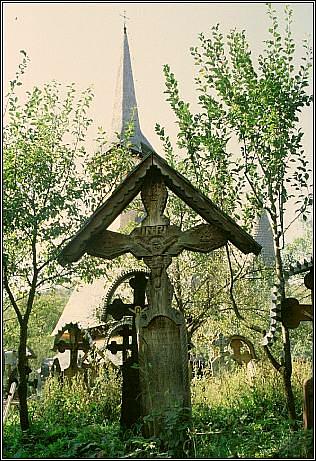 |
Those interested in religious life will discover here more than mere monuments. Certainly, Maramures is a country of dozens of wood churches, which do not stay locked as architecture
monuments, but remain opened to the parishioners that fill them every Sunday. Besides, there are a lot of active monasteries that attract processions. Some of these convents, such as that of
Rohia, own worthy collections of rare books and manuscripts.
Wood churches.Initially modelled on the peasant farmhouse, the tiny wooden churches of
Maramures impress trough their harmonious architecture and monumental outlook.
 Always oriented on the East-West axis, the church has
a ground plan consisting of a nave partinioned as follows: from the main entrance one enters an enclosed passage called pronaos or narthex, which is separated from the naos (or nave) by means of a screen made of
fretwork, latticework or wrought iron. Covered with a semicylindrical vault, the naos is the largest part of the church. The altar is placed in the sacristy, which has a
polygonal shape and is located towards the East. Always oriented on the East-West axis, the church has
a ground plan consisting of a nave partinioned as follows: from the main entrance one enters an enclosed passage called pronaos or narthex, which is separated from the naos (or nave) by means of a screen made of
fretwork, latticework or wrought iron. Covered with a semicylindrical vault, the naos is the largest part of the church. The altar is placed in the sacristy, which has a
polygonal shape and is located towards the East.
Icons and paintings - laid out according to rules specific to the rites of the Eastern Church - cover the
iconostasis, a partition that separates the sacristy from the nave.
Some churches have the main entrance covered with a porch, whose posts, arches and balustrade are akin to those of local peasant houses.
The base of the church is a frame of oak sills or girders placed on a layer of gravel with their edges resting on massive boulders. The sills hold the walls made of broad beams, whose ends
are jointed in various ways. The rafters and the purlins make up a roof frame that is sheathed with shingles. The eaves are sometimes doubled by a second row of eaves, which are very broad and go around the church.
The most impressive element of the church is the bell-tower, which adds a distinctive aesthetic quality to the edifice. The tower maintains a square section up to the level of the gallery arcades
that shelters the bells. The tower culminates in a pyramid- or cone-shaped spire that soars boldly, not unlike the steeple of Western Gothic cathedrals.
The ornamentals motifs of the wooden elements are akin to those found on gateways; the braided rope, the Sun, the cross, the serpent, the Tree of Life, as well as pre-Christian elements
that subsisted as mere graphic elements, deprived of their original symbolism, and were handed on from carver to carver.
The interior walls of the churches were painted by local artists. The biblical scenes often appear against the familiar landscape of the village. Stylistically the scenes were influenced by the
miniatures and illustrations of the Western Middle Ages and Byzantine culture.
A list of wooden churches can be seen here.
Monasteries. Not ready yet. We are sorry for any inconvenience...
|




 Always oriented on the East-West axis, the church has
a ground plan consisting of a nave partinioned as follows: from the main entrance one enters an enclosed passage called pronaos or narthex, which is separated from the naos (or nave) by means of a screen made of
fretwork, latticework or wrought iron. Covered with a semicylindrical vault, the naos is the largest part of the church. The altar is placed in the sacristy, which has a
polygonal shape and is located towards the East.
Always oriented on the East-West axis, the church has
a ground plan consisting of a nave partinioned as follows: from the main entrance one enters an enclosed passage called pronaos or narthex, which is separated from the naos (or nave) by means of a screen made of
fretwork, latticework or wrought iron. Covered with a semicylindrical vault, the naos is the largest part of the church. The altar is placed in the sacristy, which has a
polygonal shape and is located towards the East.